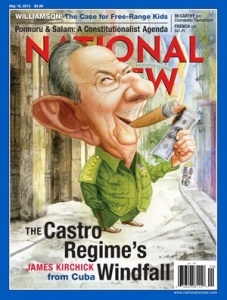Should You Travel to Cuba? The Truth: What the Real Cuba Is Like
As the normalization of relations between the United States and Cuba continues, it is important for Americans to be informed about what life on the island is really like. This is all the more necessary because our major newspapers and magazines are running features proclaiming that “now is the time to travel to Cuba,” especially before the island gets American chain restaurants and the charming 50-year-old autos disappear from the streets.
Just visit sites from National Geographic to The Nation, and you will find the itinerary, cost, and joys of a trip to Cuba. A recent issue of Bloomberg Businessweek includes Cuba in its “Take a Real Vacation” section. The article explains that one can book a tour through a “government-approved” licensed operator; one of these “specialists” offers a nine-day package, departing from Miami for $4,449 a person.
What these tourists will get is a 21st century trip through Potemkin villages.
They will learn that Cubans are a friendly people, that they love and support their Communist leaders and system, and that they believe they are better off today than they were in the ’50s before Castro came to power. They will be told that the scenic areas and preserved sections of towns they travel to are the “real” Cuba. They will stay in hotels and listen to some good music in high-priced clubs that most Cubans can’t afford to enter — even if these Cubans could get into one of the hotels, they would not be allowed to stay there.
They will come back reporting how joyous and grateful the people are, living in this socialist paradise. Finally, they will all say that if there are any economic problems, it’s the fault of the United States and the embargo that prevents them from living in prosperity.
That is why the cover story in the new issue of National Review by Jamie Kirchick on his recent trip to Cuba is so important.
Unlike the regular American tourists who are signing up for the tours, Kirchick went on his own, staying at an individual’s guest house and then a hotel. He wanted to see for himself what Cuba is really like, and most importantly, to seek out and speak to Cuba’s dissidents, most of whom are not happy with Obama’s policies.
Kirchick writes:
The relaxed travel policies, the pending opening of embassies, the removal of Cuba from the State Department’s list of terrorism sponsors, the restoration of limited economic activity — all longtime goals of the Cuban regime — were declared without any corresponding demands that Havana change its conduct.
In other words, Barack Obama is applying to Cuba the same mindset that he applies to Iran: give our adversary what they want, and eventually they will democratize and become our good friends.
The dissidents, on the other hand, want support for their movement towards democracy.
They do not want Obama’s policy, which involves legitimization of the totalitarian regime in the false hope that such measures — such as lifting the embargo — will suddenly move the Marxist-Leninist caudillos in charge of the regime to change. They want an end to the kind of experience that dissident Antonio Rodiles told Kirchik he had when he was arrested, as he stepped out of his home on the way to a scheduled free-speech demonstration.
From what Kirchick reports, Cuba hasn’t changed much since I was there for a few weeks in the summer of 1973, and wrote about my experiences in my memoir.
Ronald Radosh's Blog
- Ronald Radosh's profile
- 15 followers




